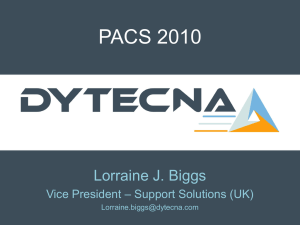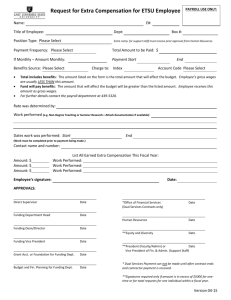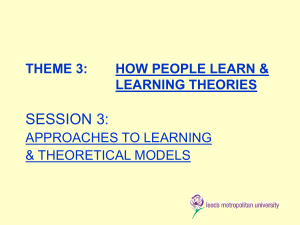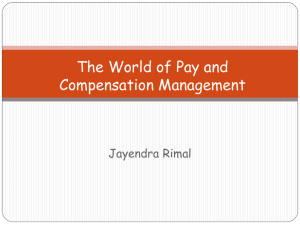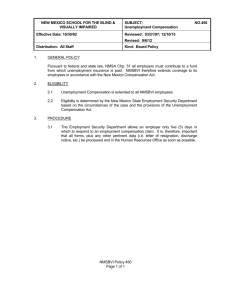critique
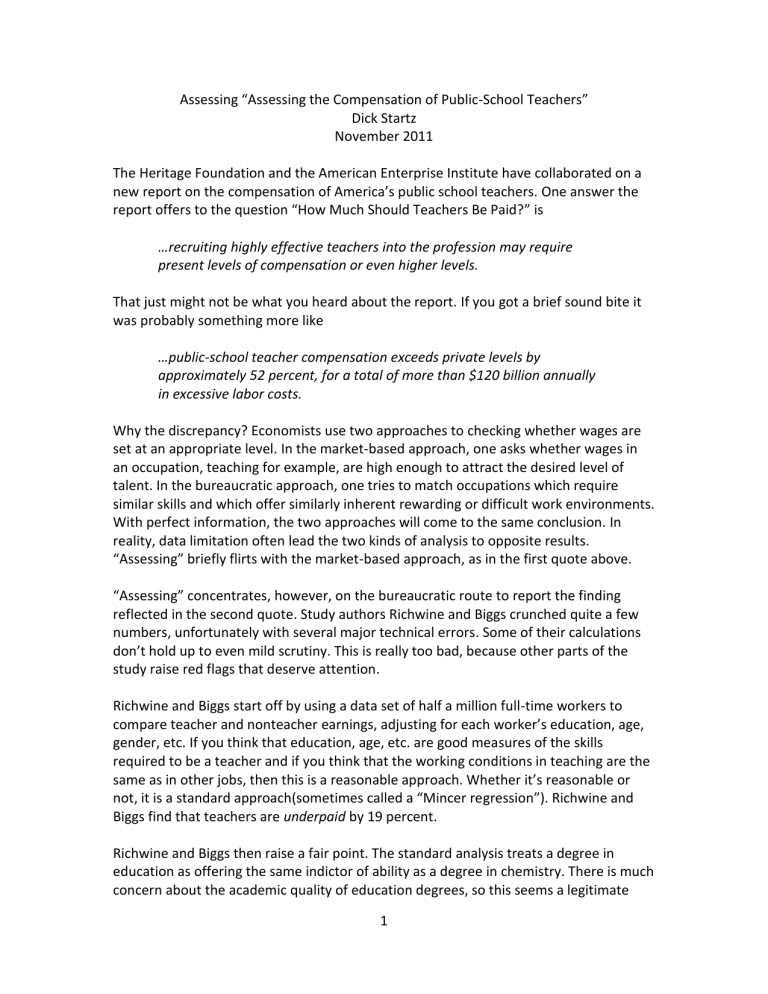
Assessing “Assessing the Compensation of Public-School Teachers”
Dick Startz
November 2011
The Heritage Foundation and the American Enterprise Institute have collaborated on a new report on the compensation of America’s public school teachers. One answer the report offers to the question “How Much Should Teachers Be Paid?” is
…recruiting highly effective teachers into the profession may require present levels of compensation or even higher levels.
That just might not be what you heard about the report. If you got a brief sound bite it was probably something more like
…public-school teacher compensation exceeds private levels by approximately 52 percent, for a total of more than $120 billion annually in excessive labor costs.
Why the discrepancy? Economists use two approaches to checking whether wages are set at an appropriate level. In the market-based approach, one asks whether wages in an occupation, teaching for example, are high enough to attract the desired level of talent. In the bureaucratic approach, one tries to match occupations which require similar skills and which offer similarly inherent rewarding or difficult work environments.
With perfect information, the two approaches will come to the same conclusion. In reality, data limitation often lead the two kinds of analysis to opposite results.
“Assessing” briefly flirts with the market-based approach, as in the first quote above.
“Assessing” concentrates, however, on the bureaucratic route to report the finding reflected in the second quote. Study authors Richwine and Biggs crunched quite a few numbers, unfortunately with several major technical errors. Some of their calculations don’t hold up to even mild scrutiny. This is really too bad, because other parts of the study raise red flags that deserve attention.
Richwine and Biggs start off by using a data set of half a million full-time workers to compare teacher and nonteacher earnings, adjusting for each worker’s education, age, gender, etc. If you think that education, age, etc. are good measures of the skills required to be a teacher and if you think that the working conditions in teaching are the same as in other jobs, then this is a reasonable approach. Whether it’s reasonable or not, it is a standard approach(sometimes called a “Mincer regression”). Richwine and
Biggs find that teachers are underpaid by 19 percent.
Richwine and Biggs then raise a fair point. The standard analysis treats a degree in education as offering the same indictor of ability as a degree in chemistry. There is much concern about the academic quality of education degrees, so this seems a legitimate
1
question. Richwine and Biggs suggest that AFQT scores are a better measure of ability than is years of education. (AFQT scores are essentially an achievement test, originally used by the armed forces.) When they use only AFQT scores, the teacher earning deficit disappears. They also run an analysis using both education and AFQT, letting the computer choose the weight for each. The results look pretty much like they did when only education was accounted for. In other words, the computer model finds that allowing for both education and AFQT scores matter. So while hypothesizing that AFQT is a better indicator of wages than is education was a fair speculation. Their own results don’t support the hypothesis. “Teachers are underpaid” won the horse race comparing just education, just AFQT scores, and both education and AFQT scores.
Given the statistical results, the authors proceed to ignore their own evidence and announce that teachers are paid about the same amount as similarly qualified workers.
This is not good science.
Richwine and Biggs turn next to fringe benefits, beginning with a comparison of the total value of benefits as a percentage of wages for teachers versus workers in the private sector. Their analysis shows that teachers receive benefits worth 41.2% of wages compared to private sector workers who receive 41.3%. So…apparently there’s no difference.
Unfortunately, the comparison group for the benefits analysis is all employees at companies with 100 or more employees. The right comparison group for teachers should be professional employees or employees with a college education or some group more similar to the teacher labor force. Using all employees misstates the relevant private sector benefits applicable to a teacher comparison.
Benefits in the private sector are generally higher for employees. How much? I don’t know. I did a quick, not very scientific, check by going to the BLS web site and looking at the data for the fraction of private sector workers who participate in retirement plans.
The number is about 50 percent for blue collar employees and about 50 percent for clerical and sales employees. In contrast, 66 percent of professional, technical, and related workers participate in retirement plans. This suggests—but doesn’t prove—that a proper private sector benefits comparison group would show substantially higher benefits. Arguably, teachers fall short on benefits as well as pay.
Continuing with the analysis of benefits, Richwine and Biggs point out quite fairly that there are differences in accounting rules for public and private pensions. The important difference is that public plans assume higher rate of return on investment. This suggests that public plans are relatively underfunded and there is an unmeasured teacher benefit because taxpayers will have to make up for the unfunded liability at a later date.
Richwine and Biggs calculate that an apples-to-apples comparison brings the value of teacher pensions compared to the private sector adds an extra 20 percentage points to the value of teacher pensions. Mind you, this assumes that if the higher rate of return
2
assumed on the public sector pensions doesn’t pan out that a subsidy will appear to make good any short fall 100 cents on the dollar. It’s not at all clear that would happen, but nonetheless there is a legitimate argument for claiming that a fair statement of teacher benefits adds about 20 percent to their relative wages.
I wish this section of “Assessing” received more attention. Quite aside from the issue of computing relative teacher compensation, Richwine and Biggs are waving a big yellow warning flag. The danger of a down-the-road meltdown in teacher pensions is starting to get notice and deserves even more.
Richwine and Biggs also point out that teachers are far more likely to receive retiree health benefits than are private sector workers. While they’re careful to explain how hard it is to value such benefits from the limited data available, they come up with a value worth 8 percent of wages versus 1.2 percent for the private sector.
Finally, the authors make one more big adjustment. They basically announce that teachers don’t work at all during the summer and that this should be counted as a 28.8 percent benefit that the authors label “work-year leave.” (The authors also assume that teachers don’t grade papers on the weekends, I guess.) Economists will reasonably distinguish between low compensation earned by a worker who works relatively few hours during the year as compared to low compensation earned by a worker who works full time all year ‘round. One suspects that teachers do work fewer hours than comparable workers, but no one really knows how big the difference is and simply measuring the difference as having the summer off really won’t do.
For example, data from the Digest of Education Statistics reports that teachers work 50 hour work weeks, which would be about 20 percent more than other comparable workers. That would pretty much offset the authors’ calculation. (But to be fair, the
Digest of Education Statistics data can be questioned too. My personal suspicion is that the longer work week is exaggerated in this data.) Teachers also spend time taking professional development classes and preparing to teach “off-the-clock.” How much uncompensated time does the average teacher put it? No one really knows. But pretending that summer vacation—the source of the 28.8 percent “benefit”—is the only difference in the teacher/nonteachers work schedule is kind of silly.
If at this point you’re thinking that teachers do work some number fewer hours per year and that this should count as part of their compensation, that’s fair enough. But then turn to the final “adjustment” that Richwine and Biggs offer. Teachers have more secure jobs than most private sector workers. The authors value this at an additional 8.6 percent of wages, made up of two components. The first component is avoiding the
“value of lost compensation due to a spell of unemployment.” But wait a minute. When you were talking about “Work-year leave” time off was a benefit. Surely the greater time off between jobs in the private sector ought to be counted (or not) in the same
3
way. The second component is “the difference between teaching and working at a new, lower-paying job.” This is simply double counting. Just cancel this “adjustment” entirely.
We should really be asking if this exercise makes any sense. But first we should finish up the numbers. The standard approach, according to Richwine and Biggs, shows teacher salaries to be 19 percent below the private sector and shows equal benefits percentages
(41 percent in both sectors), for a difference in total compensation of 19 percent.
Richwine and Biggs use the wrong comparison group for benefits. My guess is that pushes relative teacher compensation down by another 5 to 10 percent. Since I don’t have hard evidence on this point, I’ll leave it out of the scoring entirely.
Let’s grant a 20 percentage point advantage for teachers for funny accounting on pensions and another 7 percent for retiree health care. That puts the teacher benefit ratio up from 41 percent to 68 percent. So relative teacher compensation is 19 percent lower on wages plus a higher benefits ratio. Compared to the private sector, teacher compensation is (1 − 0.19) × (1.41 + 0.27) = 1.36
versus 1 × 1.41 = 1.41. That leaves teachers about 4 percent underpaid.
We’re left with arguing about whether we want to adjust for shorter work years or not; and if we do want to adjust how large an adjustment is justified. Some adjustment \ is called for, but the 28.8 percent is a nonstarter. My personal guesstimate is that an adjustment on the order of 10 percent is reasonable. Having looked at a lot of the relevant data, I want to be clear that “guesstimate” is a good description of what we know.
The headline reads something like “teachers are overpaid by 52 percent.” A fair summary of the data presented in the paper would read more like “teachers are underpaid, but only by a little bit. If you adjust for their shorter work years, they’re probably overpaid a little bit.”
Having a better idea of the answer one really gets out of the data, let’s back up and ask about whether we have the right question. This bureaucrat’s approach to comparing wages is a pretty standard one. It’s worth doing. Unfortunately, it really only works when jobs and working conditions are the same in the groups being compared. Teaching is just different from the jobs most other college graduates do. Maybe teaching should pay less than other jobs because giving kids a hand on the way up is inherently rewarding. Maybe teaching should pay more than other jobs because life on a bad day in middle school is…well, just imagine.
Very little in this report sheds light on this question of how attractive teaching is as a job. The one exception is that the authors document that in order to attract people out of the private sector into teaching you have to give them a raise and that teachers are
4
willing to leave for the private sector while taking a pay cut. This would seem to confirm that on average teaching is the less desirable job. It doesn’t speak to the ability
To an economist, the real issue gets settled by observing the free market. (And frankly, when the Heritage Foundation and the American Enterprise Institute forget this it’s a little suspicious.) The bottom line question is “Are we paying enough money to recruit and retain teachers of the quality we need.” That’s very different from asking whether current teachers could earn more or less if they were to move to a different career.
Many observers think that the market is telling us that we’re not paying enough to get the teachers we need. That’s certainly my reading.
5
